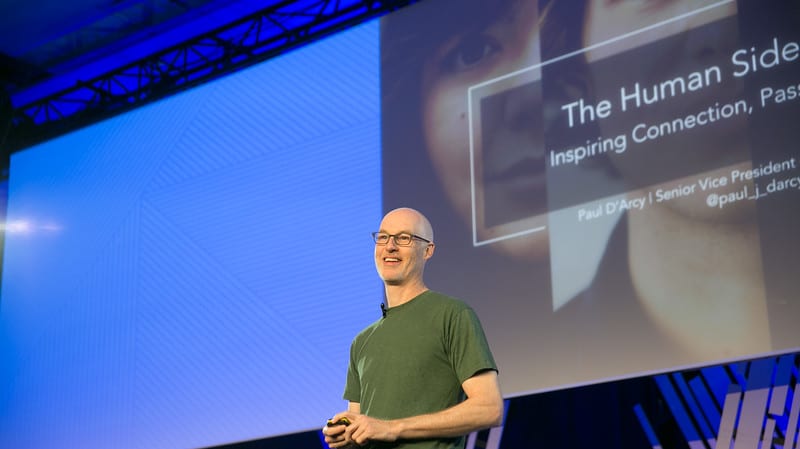
AUSTIN, Texas—Employers can build trust with job seekers and candidates by designing a hiring process that maximizes authentic human connection, Paul D'Arcy told attendees at Indeed Interactive 2017, a conference for recruiting professionals held by Indeed, the world's largest job search engine.
D'Arcy cited research showing the three events that most undermine job seekers' trust:
- Recruiters and company representatives neglect to show interest in a candidate as a person.
- The employer fails to acknowledge receipt of an application.
- Recruiters or hiring managers fail to communicate with the job seeker for a week or longer after an interview.
"When employers fail to respond to candidates promptly, they destroy their employer brand," said D'Arcy, senior vice president of marketing for Indeed. "They shrink their future talent pool—especially for top talent" who have multiple job options.
D'Arcy listed a few ways that employers could build a candidate experience that results in happier, more engaged candidates and a more productive hiring process.
[SHRM members-only toolkit: Screening and Evaluating Candidates]
Work on Culture
First, employers should work on developing the right culture to attract future employees.
"Research shows that candidates will optimize for happiness," D'Arcy said. "Eighty percent of people say they would turn down a big salary if it meant working with people or in an environment they didn't like."
In the age of online employer reviews, the voice of workers has never been stronger and candidates can readily find out how companies treat their employees, he added.
"Even if the job is great and the hiring process is flawless, candidates say that negative reviews can deter them from accepting an offer."
Some examples of companies with top-ranked workplace cultures include PNC bank, which gives its employees 40 hours of paid time off annually to volunteer together on community initiatives, and computer company Dell, which encourages its employees to volunteer in teams after internal research showed that co-worker team volunteering was one of the strongest drivers of employee engagement, D'Arcy explained.
Another way to promote collaboration is by showing interest in the things employees care about. Indeed sponsors 24-hour hackathons and projects where employees work on anything that they are passionate about.
Treat Candidates with Urgency
Candidates should be treated as if they are important customers, D'Arcy said. He noted that in most organizations, a top-quality candidate is many times more valuable than a sales lead, yet sales leads get better treatment. Sales is taught to follow up on a lead within the first five minutes. But only 9 percent of companies respond to job applications within a day, he said.
"Data show that 37 percent of applicants hear back from employers within a week, 44 percent within a couple of weeks and 15 percent have to wait months. Not surprisingly, a slow response time … is one of the most dehumanizing aspects of the hiring process," he said.
After an interview, about half of candidates hear from an employer within a week, and for about 10 percent of candidates, it takes more than four weeks, D'Arcy said.
On the other hand, office supplier Staples provides an overview of the hiring process for candidates "that's incredibly clear and sets expectations for follow-up at each stage. Even though it may take longer to respond, if an organization is clearer about that upfront, it's often OK with job seekers," he said.
He added that global telecom company AT&T provides an online status for all applicants and a dedicated job support telephone line for job seekers to call anytime to ask questions about the process.
Act as Advocates for Talent
"Recruiters have an incredible opportunity that is not always used," D'Arcy said. "They can be forceful defenders of talent, building connection and trust while helping candidates shine in the interview process."
He noted that 84 percent of candidates who reported receiving detailed preparatory information prior to an interview but were not selected ranked the candidate experience as positive. Yet, 33 percent of candidates said they received no preparation communication at all about the interview other than a time and place to meet.
D'Arcy cited a typical e-mail from a Google recruiter to a candidate about to interview, which contained:
- Information about the role.
- The hiring philosophy specific to the role.
- What to expect in the interview process.
- A breakdown of the evaluation criteria.
- Sample questions.
- What not to expect.
- Extensive details on how to prepare.
With a list like this, "A candidate has everything they need to be their best," he said.
Capitalize on Data
Finally, talent acquisition must use data to "relentlessly optimize for human connection," D'Arcy said. "The only way to truly build a successful candidate experience is to measure how candidates respond to your recruiting process."
Data show that perceptions of candidate experience have an incredible impact on all recruiters' ability to attract top talent. Candidates who have had a positive experience are likely to apply again. They are also likely to refer additional people. Those who have had a bad experience will more than likely not reapply or refer candidates.
"Yet many companies today don't fully measure the impact," D'Arcy said. "Almost 90 percent of people who rated candidate experience poorly were never asked for their feedback."
Was this article useful? SHRM offers thousands of tools, templates and other exclusive member benefits, including compliance updates, sample policies, HR expert advice, education discounts, a growing online member community and much more. Join/Renew Now and let SHRM help you work smarter.
Advertisement
An organization run by AI is not a futuristic concept. Such technology is already a part of many workplaces and will continue to shape the labor market and HR. Here's how employers and employees can successfully manage generative AI and other AI-powered systems.
Advertisement


